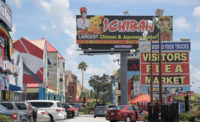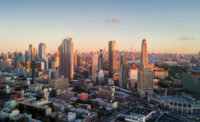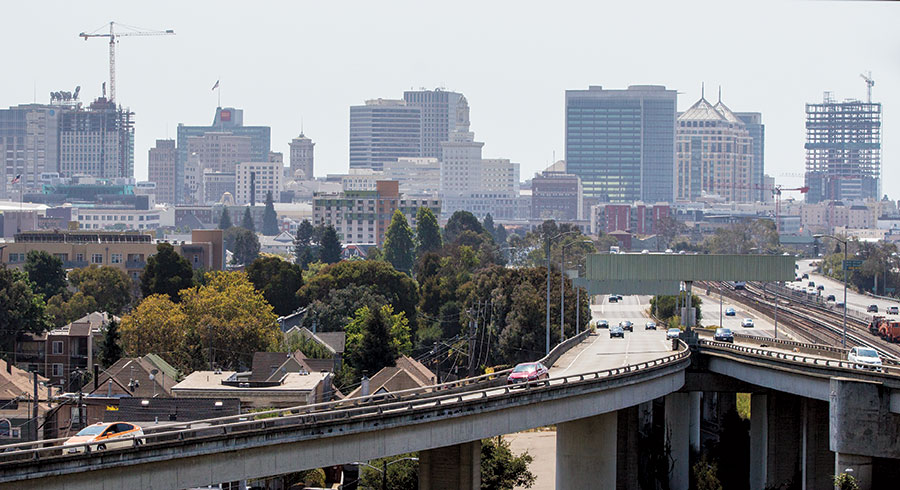The Housing Crisis in Oakland

Oakland, just across the bay from San Francisco, is a city of housing contrasts.
Photo © Jessica Christian

Examples of recent and current projects are 1640 Broadway—a market-rate tower that includes such amenities as a rooftop lounge—and garden sheds (shown) installed under a freeway for people who formerly lived in tent camps on the same site.
Photo © Jessica Christian

Examples of recent and current projects are 1640 Broadway (shown)—a market-rate tower that includes such amenities as a rooftop lounge—and garden sheds installed under a freeway for people who formerly lived in tent camps on the same site.
Image courtesy Solomon Cordwell Buenz

The city, which covers 78 square miles, has varied topographies, including the popular recreation spot, Lake Merritt.
Photo © Jessica Christian

A mixed-use development known as the Hive, occupies the site of a former car dealership.
Photo © Jessica Christian

More than a decade after the approval of 3,100 housing units on former port land in Brooklyn Basin, the first apartment buildings are finally on the rise.
Photo © Eric Kayne






The state of the Oakland housing market in 2018—what is needed and what’s actually being built—can be gauged by a pair of very different new developments located within this city of 425,000 that lies eight miles and a deep body of water directly east of San Francisco.
One is a 33-story tower at 1640 Broadway, designed by Solomon Cordwell Buenz, that will hold 254 apartments atop an artfully screened parking podium when it opens next spring; monthly rents are likely to start above $2,500 for the smallest studio apartments, with amenities that will include a rooftop lounge with fire pits. The other, located less than 12 blocks away, is decidedly more humble—a cluster of 20 repurposed garden sheds nestled against an elevated highway at 27th Street and Northgate Avenue. Each upgraded shed holds two people who formerly lived in tent camps near the site that were cleared by the city after the “community cabins” opened in May; the doors have deadbolts, and there are double-pane windows to muffle the freeway noise. But toilet facilities are shared, and each shed has only enough electricity to power a single light and recharge cell phones.
Extremes of this sort are seen today across urban America, but they’re particularly troubling in one of the nation’s most racially diverse large cities, and one that in recent years has pursued a wide range of initiatives to provide and protect housing for people of all income levels. Yet with the San Francisco Bay Area’s tech-fueled economic boom still at full force, Oakland instead is showing how tough it can be for any city in a prosperous region to control its fate.
“It’s not easy to hold back the tide of change,” says Carol Galante, a professor of affordable housing and urban policy at the University of California, Berkeley, College of Environmental Design. Before that, the Oakland resident spent five years as an assistant secretary at the U.S. Department of Housing and Urban Development. “Oakland’s trying to hold on to the [racial and economic] balance that residents value, but it’s not a given that they’ll be able to.”
Simple numbers tell much of the story. Since the end of 2012, a period during which the Bay Area added roughly 600,000 jobs, the median price of a home in Oakland more than doubled from $260,400 to $638,100, according to the real-estate analysis firm Metrostudy. In the city center districts known as Downtown and Uptown, there are more than a dozen market-rate housing complexes under construction or recently completed. Also on the rise is the city’s homeless population—the official federal count of 2,761 in 2017 was 25 percent higher than the one taken two years earlier. By contrast, the homeless numbers for San Francisco during that period remained stable.
| Population: | Median Price of Home in 2012: | Median Price of Home in 2017: | Average Rent for 1-BR Apartment in 2012: | Average Rent for 1-BR Apartment in 2017: |
| 425,000 | $260,400* | $638,100* | $1,562** | $2,361** |
Source: *Metrostudy **Rainmaker Insights
What the numbers don’t capture is the tension in a city that long has prided itself on being an authentic place unto itself, the Town to San Francisco’s the City.
To understand why, put aside the notion that this is the West Coast’s version of Brooklyn, an adjunct to the main attraction. Oakland is defined by a variety of communities and topographies—from Lake Merritt, a popular spot for strolling and picnicking that flanks downtown, to the tree-shrouded residential hills along the city’s eastern edge. Broadway, the onetime commercial spine, struggled for decades but now features such attractions as Oaklandish, where locally made T-shirts extoll the Port of Oakland’s industrial cranes, or the Hive, a rough-edged makeover of a car dealership that goes beyond the standard 21st-century millennial fare to include an African-American-owned coffee roaster that used crowdfunding to set up shop.
But Broadway is also a 12-minute rapid-transit ride under the bay from San Francisco. Perennially desirable Berkeley shares Oakland’s north border. Gentrification pressures date back at least to the 1980s, waxing and waning with the region’s economic tides.
The difference with the current wave of prosperity is its longevity. The growth in jobs and housing demand has been insistent since 2012, altering the landscape in profound ways. Facebook, for instance, is headquartered in Menlo Park, near Stanford University. However, it has leased all 1.2 million square feet of office space in two new towers in San Francisco’s Financial District. The more that Silicon Valley expands, the more convenient—and compelling—Oakland becomes to young, affluent workers who want to feel that they’re part of a scene.
“The housing affordability problem has been in the making for decades. The challenge this time is the speed of the change, and the intensity,” says Darin Ranelletti, the policy director for housing security for first-term mayor Libby Schaaf. “It’s the breadth and depth of the crisis.”
That crisis can take a deadly turn: think back to December of 2016, when 36 people were killed in the fire at a warehouse that had been turned into an ad hoc artist collective. Rents were kept low in part by ignoring basic building codes. The resentment of perceived economic inequality and disruption can also lead to such destructive acts as a quartet of arsonous fires in 2016 and 2017 that leveled market-rate apartment buildings during construction.
Amid all this, the Schaaf administration convened a “housing cabinet” that in 2016 released a 52-page report with detailed recommendations on how to offset housing pressures, both by encouraging the development of 17,000 additional housing units by 2024, and by protecting a similar number of households that otherwise might be displaced.
The production side of the equation is easy to track: Oakland has issued permits for 9,710 housing units since the end of 2015. More than 6,500 currently are under construction, with another 11,900 in the pipeline. Zoning was revised to ease restrictions on accessory dwelling units in the backyards of single-family homes; there were 61 such cottages approved in the first six months of 2018, which may not sound like much, but in all of 2017 there were just 57.
What’s more intriguing are the efforts to preserve housing options for low- and middle-income residents. City residents approved a measure in 2016 to extend rent-control protections to buildings constructed as recently as 1995 (the prior cutoff was 1980). A $600 million infrastructure bond approved in the same election includes $100 million for such initiatives as the purchase of residential buildings by nonprofits that will then guarantee permanent affordability. Eight properties have changed hands so far—from a handful of single-family homes to a 66-room single-occupancy hotel.
In a similar vein, Oakland is using streamlined paperwork and a $500 signing bonus to entice landlords to rent apartments to residents with vouchers from the federal housing assistance program, popularly called Section 8. Early signs are promising—there were 684 new Section 8 leases in Oakland in the first six months of 2018, twice the number of the year before.
“The most pressing issue in Oakland right now is housing security,” says Ranelletti, who has worked at City Hall since 2003 and at one point was interim planning director. “What we’re trying to do goes beyond housing as buildings and units. People should feel secure in their homes.”
The “community cabins” weren’t in the 2016 recommendations. Rather, they’re a city-organized but privately funded response to the spread of homeless encampments that in some cases line underpasses or spill into lightly trafficked roadways. The site planning and upgrades to the sheds were done with the assistance of Michael Pyatok, an Oakland architect who is one of the nation’s best-known designers of affordable housing. He stepped in on the cabins, which are accompanied by support services, because he recognized an opportunity for a quick fix to a daunting problem. “They’ll keep someone warm, keep someone safe, and that’s a huge step upward from the streets,” Pyatok says. As for the greater array of housing challenges that face Oakland, he sees a limited role for architects: “It’s so much larger than design solutions. We’re the caboose in the development train, not the engine.”
It’s hard to look at the current situation and not want to turn back the clock. Market-rate developers have only been required to pay a housing-impact fee or include lower-income units in their projects since 2016; 1640 Broadway and many of the other current projects under construction, since they already were in the planning process, include no “affordable” apartments. And while the initiative to help non-profits purchase apartment buildings filled with working-class families is admirable, the money would have gone further if the city had intervened aggressively during the depths of the 2008 recession to purchase foreclosed-on houses in struggling African-American neighborhoods that now are being gentrified.
But governments respond to the pressures of the moment, and not always with effective speed. Housing-impact fees were brushed aside by prior administrations, except for one analysis completed the year before the Great Recession seemed to make it moot. And though the Oakland City Council in 2009 steered $5 million to a community land trust that was to step in and buy 200 foreclosed-on houses, the process moved so slowly that the trust ended up purchasing fewer than two dozen.
“By the time they got started and organized, speculators already were circling East Oakland and picking up foreclosed properties for a song,” recalls Karen Chapple, a professor of city and regional planning at UC-Berkeley who has studied housing trends in Oakland for the past decade. “It’s very hard to think as fast as the market does. We’re well-intentioned folks, but they’re always ahead.”
Today’s good intentions also run up against the entrenched realities of California, a state where residents have spent decades perfecting the art of obstruction. Often this has been for admirable reasons, such as preserving the open ridgelines and farmland that kept the Bay Area from congealing into one mass of sprawl. It also means a political culture where suburbs may be self-righteous about blocking growth. Look at Silicon Valley’s Cupertino, where computer giant Apple is based—and state figures show that just 27 housing permits were issued in 2017, the same year that Apple opened its Foster + Partners–designed headquarters that holds 3,000 workers.
In Oakland, the hurdles facing large projects can be seen in the 65 acres of former port land now known as Brooklyn Basin. After years of debate, 3,100 housing units were approved in 2006, with 460 to be reserved for low-income residents. Opponents then filed a lawsuit challenging the environmental-impact report, a common tactic to slow down and perhaps derail a project. They lost, as most opponents do—but the combination of the legal delays and the recession means that the first units are only now being built.
It’s this backdrop that makes some observers fatalistic about what Oakland can do.
“The numbers that can be produced are nothing like demand or the indirect forces of displacement that have been set into motion,” Chapple says. “It’s almost like a Band-Aid.”
Ranelletti takes the broad view that any solution to Oakland’s bind must be regional, and that a more aggressive state investment is needed in areas like housing subsidies and homeless-assistance programs. Nonetheless, he holds out hope that local efforts can make a beneficial mark. “I’m optimistic,” says the City Hall veteran. “I think it’s absolutely solvable, or I wouldn’t be doing it.”












